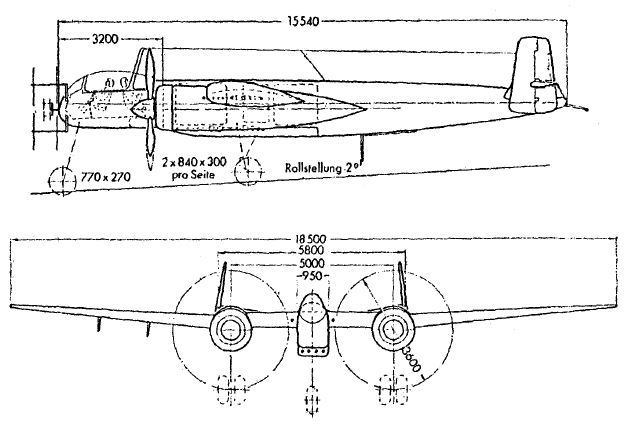
The Heinkel He 219 is commonly considered as one of the best night fighters of World War II, and when it entered service in 1943, it was the world's first operational aircraft equipped with ejection seats. This aircraft is thus a true milestone in aviation history, with the restoration of the last surviving aircraft nearing completion at the National Air and Space Museum, see photo below.

Technical Data He 219 A-0 |
 |
|
| Length: | 15.54 m | |
| Wingspan: | 18.50 m | |
| Height: | 4.40 m | |
| Wing Area: | 44.50 m² | |
| Engines: | 2 x DB 603 A | |
| 1750 PS | ||
| Range: | 2,400 km | |
| Usage: | Nightfighter | |
| Crew: | Pilot and Radio Operator | |
| Armament: |
2 MG151/20 in wing roots, supplemented by one of the following armament kits below fuselage: Rüstsatz I: 4 x MG 151/20 Rüstsatz II: 4 x MK 108 Rüstsatz III: 4 x MK 103 |
|
| Empty Weight: | 9,857 kg | |
| Gross Weight: | 12,547 kg | |
Recent research by our friend R. Francis Ferguson (Heinkel He 219 - A Research Paper) has revealed many inconsistencies in the publications on this fascinating aircraft so far - which also means that part of the chapter on the competitive situation between the Junkers Ju 388 and the Heinkel He 219 in our book will have to be re-written - a challenge that we will eagerly take up...
Some initial bits of information below - please keep checking back to this page for more information!
Faced with ever increasing production demands by the Luftwaffe and substantial numbers of its regular workforce being drafted away to military service in the Wehrmacht, Heinkel, like most of Germany's industrial companies, faced severe productivity challenges.
Like most other companies, Heinkel sought to compensate the loss of its German workforce by foreign labour. While Heinkel corporate records typically only use the generic term Ausländer (foreigners), it seems valid to assume that virtually all of these persons had been compelled to work for Heinkel in some way or another. Maintaining production and development under these conditions proved to be a formidable challenge. Evidently, language barriers and the qualification of the assigned labour were a persistent concern to Heinkel. During a discussion on the He 219 pre-series and serial production at the Reichsluftfahrtministerium (RLM) in Berlin on March 5th, 1943, Director Karl Hayn, head of all Heinkel production plants, complained that it was "impossible to conduct [aircraft] development with Russian women and other foreign-language persons, who can neither read technical drawings, nor communicate in any other way" [1]. At the end of July 1943, only 28% of the male workers at the Heinkel production plant in Rostock were still German [2]. Always desperate for more workers, the Heinkel company showed remarkably low scruples when it came to the involvement of concentration camp inmates in its production, and aggressively pushed for corresponding forced labour assignments with officials. In fact, Heinkel can be said to have pioneered the exploitation of concentration camp prisoners in the German defence industry - an inglorious and disreputable achievement.
It was therefore routine that, in order to obtain the required working force for the He 219 pre-series production line in Vienna, Director Hayn negotiated with SS-Obersturmbannführer (lieutenant colonel) Gerhard Maurer, who was responsible for coordinating the assignment of concentration camp inmates to industry as forced labour at SS-Wirtschafts- und Verwaltungshauptamt. Hayn and Maurer planned to fly to Vienna together on August 17, 1943 to discuss "the options available" for involving concentration camp inmates at the Schwechat plant on site. Technical Director Carl Francke was asked to be present at this meeting as well to discuss the possibility of establishing a KZ-Konstruktionsbüro, i.e. the possibility of employing camp inmates in the design office [2]. Earlier in the summer, the Director of the Vienna plant, Joseph Schaberger, had considered to dislocate the construction of large fixtures for the He 219 A-0 pre-series to Lichtenwörth near Wiener Neustadt (Austria), which provided "the opportunity to staff the production mainly with concentration camp inmates". However, it was "a prerequisite to have German KZ inmates available in sufficient number" to accomplish this task. Due to its "secluded architecture", Lichtenwörth "seemed particularly suited as a concentration camp plant" [3].
Apparently, at least part of these plans came to fruition. During a visit to the Vienna-Schwechat plant in early October 1943, Fl.-Stabsing. Bohn and Mr. Magerstedt from the RLM (GL/C-Fert.) expressed their astonishment concerning the poor workmanship they had seen on the He 219 A-0 aircraft currently in production. Heinkel representatives replied that this was due to the fact that their urgent request for skilled German labour had not been fulfilled, even after several months of waiting. Rather, of the some 1600 new recruits that had been assigned to Heinkel-Vienna in the previous three months, 784 were concentration camp inmates, the remainder foreign workers from different countries. Since "the number of craftsmen among these people" was "negligibly small", at least "three months of vocational training" were required [4].
Prof. Dr. Ernst Heinkel initially suggested the nickname Hermes for the He 219. However, the RLM refused this on the basis that all Luftwaffe aircraft should be named after predators or birds of prey, and originally suggested the name Marder (marten) instead in December 1943 [5]. The name Uhu (owl) does not appear in wartime Heinkel documents on the aircraft. For the nightfighters specially tuned to hunt the British "Mosquito", it was proposed to use Maskottchen (mascot) - possibly a deliberate malapropism of the German word Moskito - as a camouflage name.
From the makers of